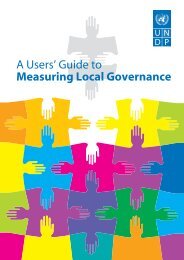English - UNDP
English - UNDP
English - UNDP
You also want an ePaper? Increase the reach of your titles
YUMPU automatically turns print PDFs into web optimized ePapers that Google loves.
Project<br />
Building national capacities for<br />
implementation of poverty reduction<br />
strategies (2007)<br />
team with partners from the central and local level. The analysis<br />
included a review of results from the previous Communities<br />
Programme (including DGTTF projects) and the key objectives<br />
and priorities as highlighted in the national development<br />
framework 28 . Therefore, by addressing regional and district<br />
development discrepancies, capacity gaps at the district levels<br />
in planning, budgeting, and financial management, along with<br />
lack of aid coordination mechanisms at the district level, the<br />
project proved highly relevant.<br />
The project intervention remained valid and relevant throughout<br />
its implementation: its results and targets, defined during the<br />
formulation phase, remained relevant during its implementation<br />
and adjustments were not needed.<br />
Project title<br />
Building national capacities for implementation of<br />
poverty reduction strategies<br />
Effectiveness<br />
The project’s expected results were completed, contributing<br />
to the achievement of the overall objective.<br />
Duration January – December 2007<br />
The project’s key achievements included:<br />
Funding<br />
Aim<br />
Results<br />
US$130,000 from DGTTF<br />
To address district development differences through<br />
participatory mechanisms for identification of<br />
development priorities<br />
a District Development Plans elaborated in three<br />
Zarafshan Valley districts<br />
a Comprehensive capacity development<br />
programme for elected representatives and civil<br />
servants from the district and jamoat level<br />
a Improvement of the government’s information<br />
systems for planning, monitoring and evaluation<br />
of public policy<br />
The project aimed to address district development differences<br />
through participatory mechanisms for identifying development<br />
priorities. Specifically, it facilitated preparation District<br />
Development Plans in three Zarafshan Valley districts, using<br />
a participatory approach. In parallel, the project worked to<br />
enhance the capacities of elected representatives and civil<br />
servants from the district and jamoat levels to prioritize poverty<br />
reduction activities. At the national level, the project supported<br />
improvement of the government’s information systems for<br />
planning, monitoring, and evaluation of public policy. The<br />
project achieved all its objectives.<br />
Relevance<br />
The project was designed coherently and based on a detailed<br />
participatory approach involving stakeholders (target groups<br />
and beneficiaries) from the central government and district<br />
levels. The programming process followed an established model:<br />
the situation and needs analysis were conducted by the <strong>UNDP</strong><br />
a The district development plans, which were implemented<br />
in three Zarafshan Valley districts, based on locally<br />
identified priorities and results of a baseline survey. The<br />
documents were also linked to National Development<br />
Strategy, Poverty Reduction Strategy, and MDG indicators<br />
to balance local needs with national priorities. From the<br />
perspective of district authorities and district development<br />
committee members, the plans served as a mechanism<br />
for coordinating the contributions of different actors<br />
to local development, including international assistance.<br />
By linking budget/financial resources with the District Development<br />
Plan, local authorities and citizens increased<br />
their awareness of the budget allocation system and reforms<br />
needed for full-fledged application of bottom-up<br />
planning and budgeting.<br />
a The project designed and implemented a comprehensive<br />
training programme: i) training on planning for district<br />
authorities and jamoat representatives; ii) training<br />
on poverty reduction planning and monitoring for the<br />
Economic Reforms, Statistics, and Finance departments,<br />
the Land Committees, the District Employment Centres;<br />
and iii) training for participatory budgeting and planning<br />
for councillors (local council deputies) and district finance<br />
officers.<br />
28<br />
Priorities are highlighted in the National Development Strategy, the PRS and<br />
the Public Administration Reform Strategy.<br />
18








![GuÃa del Usuario ] - Governance Assessment Portal](https://img.yumpu.com/44740603/1/190x253/gua-a-del-usuario-governance-assessment-portal.jpg?quality=85)








